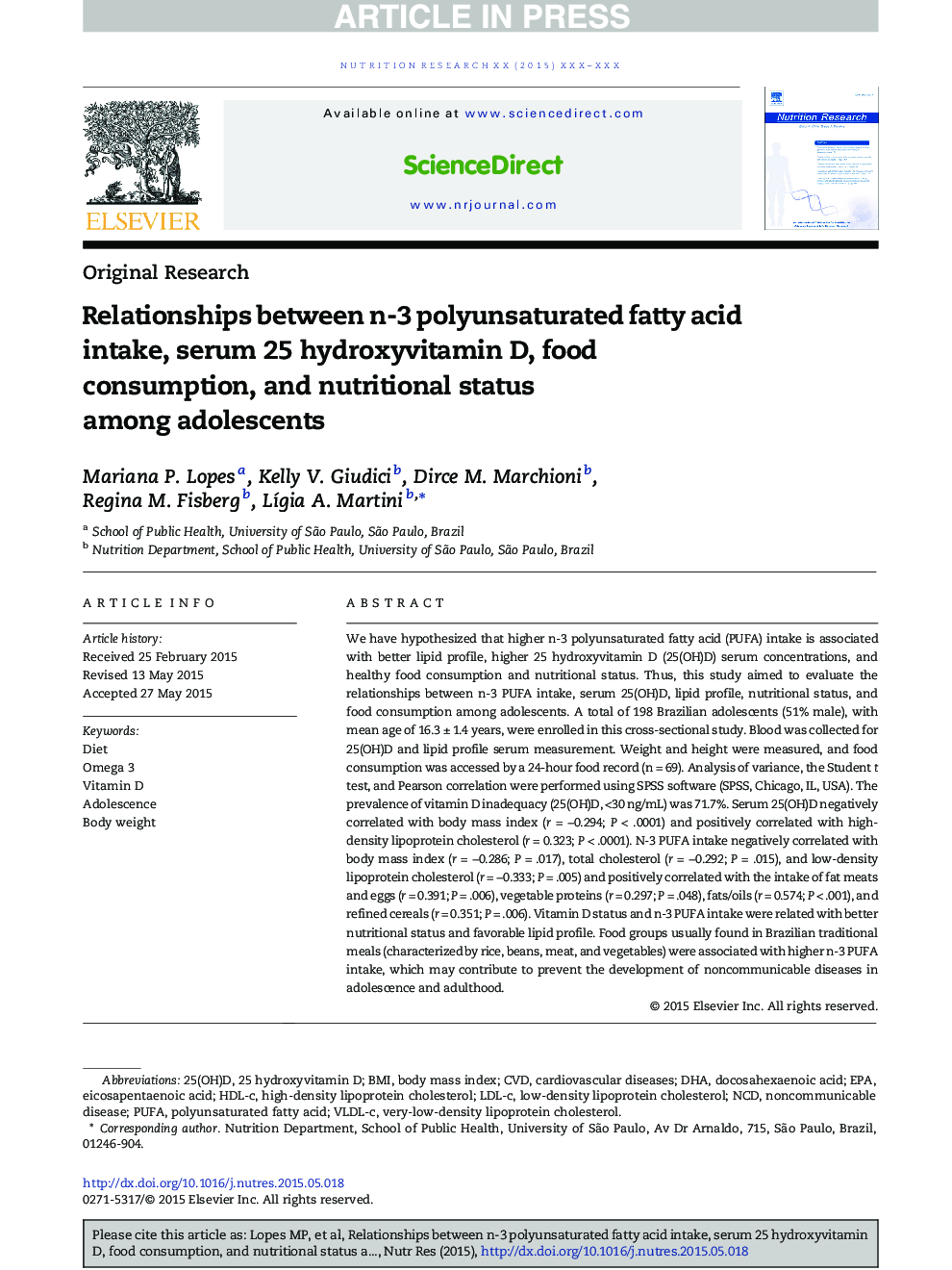| کد مقاله | کد نشریه | سال انتشار | مقاله انگلیسی | نسخه تمام متن |
|---|---|---|---|---|
| 5904344 | 1157978 | 2015 | 8 صفحه PDF | دانلود رایگان |
عنوان انگلیسی مقاله ISI
Relationships between n-3 polyunsaturated fatty acid intake, serum 25 hydroxyvitamin D, food consumption, and nutritional status among adolescents
دانلود مقاله + سفارش ترجمه
دانلود مقاله ISI انگلیسی
رایگان برای ایرانیان
کلمات کلیدی
VLDL-CEPANCDHDL-CLDL-C25(OH)D - 25 (OH) D25 hydroxyvitamin D - 25 هیدروکسی ویتامین دEicosapentaenoic acid - اسید ایکوزاپنتانوئیکdocosahexaenoic acid - اسید داکوزاگزوائونیکPolyunsaturated fatty acid - اسید چرب غیر اشباعPUFA - اسید چرب چند غیراشباعOmega 3 - امگا 3Adolescence - بلوغ، دوره جوانی، نوجوانیNoncommunicable disease - بیماری غیر مسریCardiovascular diseases - بیماری قلبی-عروقی DHA - دوکوساهگزائنوئیک اسیدCVD - رسوب دهی شیمیایی بخار Diet - رژیم غذاییbody mass index - شاخص توده بدنBMI - شاخص توده بدنیhigh-density lipoprotein cholesterol - لیپوپروتئین پرچگالی یا اچدیالbody weight - وزن بدنVitamin D - ویتامین دیLow-density lipoprotein cholesterol - کلسترول لیپوپروتئین با چگالی کمVery-low-density lipoprotein cholesterol - کلسترول لیپوپروتئین با چگالی کم
موضوعات مرتبط
علوم زیستی و بیوفناوری
بیوشیمی، ژنتیک و زیست شناسی مولکولی
علوم غدد
پیش نمایش صفحه اول مقاله

چکیده انگلیسی
We have hypothesized that higher n-3 polyunsaturated fatty acid (PUFA) intake is associated with better lipid profile, higher 25 hydroxyvitamin D (25(OH)D) serum concentrations, and healthy food consumption and nutritional status. Thus, this study aimed to evaluate the relationships between n-3 PUFA intake, serum 25(OH)D, lipid profile, nutritional status, and food consumption among adolescents. A total of 198 Brazilian adolescents (51% male), with mean age of 16.3 ± 1.4 years, were enrolled in this cross-sectional study. Blood was collected for 25(OH)D and lipid profile serum measurement. Weight and height were measured, and food consumption was accessed by a 24-hour food record (n = 69). Analysis of variance, the Student t test, and Pearson correlation were performed using SPSS software (SPSS, Chicago, IL, USA). The prevalence of vitamin D inadequacy (25(OH)D, <30 ng/mL) was 71.7%. Serum 25(OH)D negatively correlated with body mass index (r = â0.294; P < .0001) and positively correlated with high-density lipoprotein cholesterol (r = 0.323; P < .0001). N-3 PUFA intake negatively correlated with body mass index (r = â0.286; P = .017), total cholesterol (r = â0.292; P = .015), and low-density lipoprotein cholesterol (r = â0.333; P = .005) and positively correlated with the intake of fat meats and eggs (r = 0.391; P = .006), vegetable proteins (r = 0.297; P = .048), fats/oils (r = 0.574; P < .001), and refined cereals (r = 0.351; P = .006). Vitamin D status and n-3 PUFA intake were related with better nutritional status and favorable lipid profile. Food groups usually found in Brazilian traditional meals (characterized by rice, beans, meat, and vegetables) were associated with higher n-3 PUFA intake, which may contribute to prevent the development of noncommunicable diseases in adolescence and adulthood.
ناشر
Database: Elsevier - ScienceDirect (ساینس دایرکت)
Journal: Nutrition Research - Volume 35, Issue 8, August 2015, Pages 681-688
Journal: Nutrition Research - Volume 35, Issue 8, August 2015, Pages 681-688
نویسندگان
Mariana P. Lopes, Kelly V. Giudici, Dirce M. Marchioni, Regina M. Fisberg, LÃgia A. Martini,